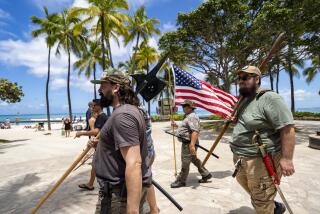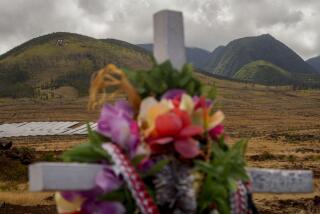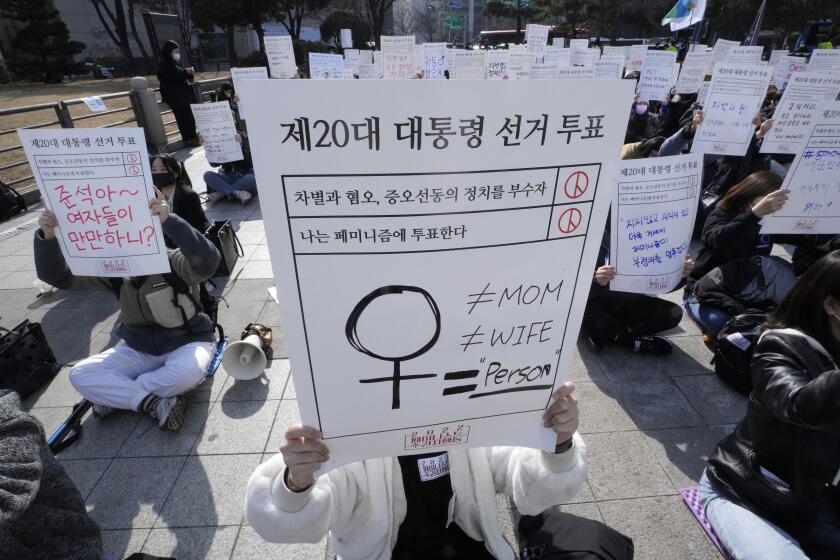Joyous Hawaiians Reclaim Battered Kahoolawe Island From Military : Conservation: Once a target for shelling, the 45-square-mile symbol of native culture is handed to the state in a ceremony ending a long struggle.
- Share via
PALAUEA, Hawaii — Barefoot men in loincloths blew conch shells 100 times here Saturday as Hawaiians celebrated the end of a long struggle to reclaim the island of Kahoolawe from the U.S. military.
“This is a historic event,” said Leslie Kuloloio of the Protect Kahoolawe Ohana (Family), who joined several hundred people for ceremonies at a sandy cove on the southwest coast of Maui, the closest point to the deserted island. “We used no violence, no guns, just the law and our total belief in the truth of what we were doing.”
Commandeered by the Navy for target practice during World War II, Kahoolawe had been bombed and strafed for more than a generation when nine protesters occupied it in 1976 in an attempt to stop the shelling.
Their arrests for trespassing kicked off a David-versus-Goliath battle that culminated in Saturday’s formal transfer of the 45-square-mile island to the state of Hawaii.
It will be held in trust for a sovereign Hawaiian nation, should one someday be recognized by state and federal officials.
The fight for Kahoolawe (pronounced Kah-HO-oh-lah-vey) has come a long way. Once dismissed as ragtag radicals, the Protect Kahoolawe Ohana championed a cause that eventually became the heartbeat of a movement by native Hawaiians seeking self-determination.
Dr. Noa Emmett Aluli, one of the original protesters, is now chairman of the Kahoolawe Island Reserve Commission, created last year to oversee the island’s rebirth as a cultural sanctuary.
On Saturday, the physician joined Gov. John Waihee and Deputy Assistant Secretary of the Navy William J. Cassidy Jr., to sign documents detailing the island’s return and cleanup.
The governor himself is no stranger to the cause. As a young lawyer, he helped defend some of the protesters.
The lei-bedecked crowd, clad in shorts and tropical prints, burst into applause as the men held the papers aloft.
“With the return of Kahoolawe, it feels like Hawaii is whole again,” the governor said.
Two storytellers traced the history of Kahoolawe and welcomed it back to the family of Hawaiian Islands, the low tones of their chants rolling with the surf.
Organizers had hoped to hold Saturday’s ceremony on Kahoolawe, but the logistics proved impossible. Instead, Ohana members, Navy officials and spectators gathered here in sight of the island.
While Kahoolawe is now a cause celebre embraced by the highest levels of government, that was far from the case when the Ohana members banded together to proclaim it a Hawaiian treasure in the mid-1970s. They were considered troublemakers, and their efforts to challenge the U.S. government were denounced as foolhardy.
The smallest and driest of the eight main Hawaiian Islands, Kahoolawe seems an unlikely prize. The dusty, arid island was leased to ranchers early in the century. Goats stripped its greenery, and erosion slashed deep gullies in its sides. Since 1941, nearly every type of conventional ordnance in the U.S. military’s inventory has pounded its red dirt.
But the uninhabited, unassuming island became a powerful symbol for the Hawaiian people. To many, it represented the most stark desecration of the native tradition of “aloha aina,” or love for the land. And the struggle to save it fired a cultural and spiritual renaissance among native Hawaiians.
“Kahoolawe made people really feel good about being Hawaiian again,” Aluli said.
A. Frenchy DeSoto, a Hawaiian elder and Ohana member, said that before the Kahoolawe protest, “we were becoming not Hawaiians but brown Westerners who were like flotsam on the ocean, with no real sense of cultural identity or place.”
More trespassers followed the first boatload, eluding Navy searches. Two young men, including one of the Ohana’s most charismatic leaders, were lost at sea on a rescue mission for other protesters, becoming martyrs for the cause.
In 1976, the Ohana sued the Navy, seeking enforcement of laws governing protection of the island’s environment, preservation of historic sites and freedom to practice their religion.
A consent decree signed in 1980 restricted the bombing and gave the group regular access to the island for religious, cultural and educational activities.
As a result of the Ohana’s efforts, the entire island was placed on the National Register of Historic Places in 1981. Despite the shelling, it remains rich in archeological sites and offers a rare glimpse of ancient Hawaii. Petroglyphs are etched on its flanks, and fishing shrines dot its coast.
Ohana members have rededicated old shrines and replanted native vegetation. During monthly visits to the island, they live in the old way, diving for fish and prying limpets off lava rocks. To reach the undeveloped island, they must drop anchor offshore, form a human chain and pass their belongings through the surf to the beach, where they camp.
More than 5,000 people have visited the island under the Ohana’s auspices. Through the 1980s, support for reclaiming Kahoolawe spread across the state and even abroad. One foreign nation after another dropped out of joint military exercises on Kahoolawe.
In 1990, President George Bush ordered the bombing stopped temporarily. Last year, Congress voted to permanently halt all military exercises and return title to Hawaii, authorizing $400 million for cleanup and restoration of the island.
Access will remain limited while the Navy removes ordnance from the island during the next 10 years. Unexploded shells and bombs stud its landscape and near-shore waters.
Hawaiians envision Kahoolawe as a retreat that could become the centerpiece of native culture. In setting it aside as a cultural reserve, the state has prohibited commercial activity.
“Kahoolawe will be a place for all of us to find a peaceful corridor--no noise, no lights . . . and making contact with the Creator and our ancestors,” Kuloloio said. “That’s what’s been lost here in Hawaii and throughout the world.”
More to Read
Sign up for Essential California
The most important California stories and recommendations in your inbox every morning.
You may occasionally receive promotional content from the Los Angeles Times.













